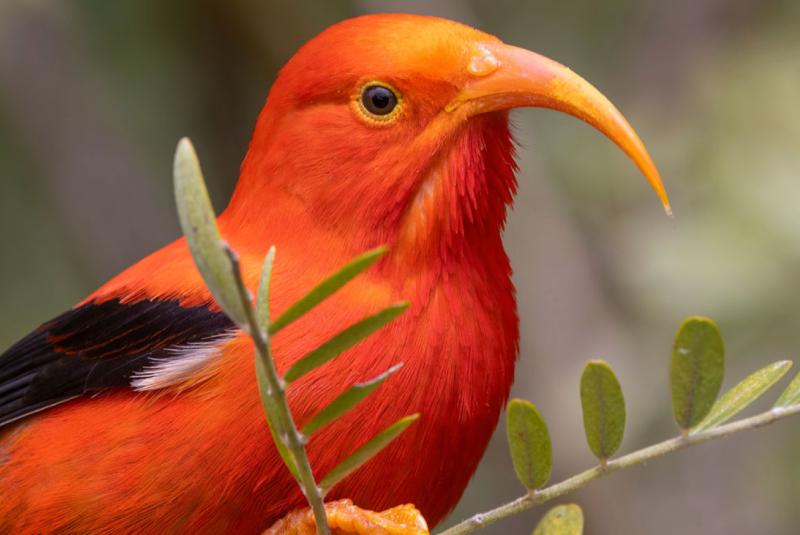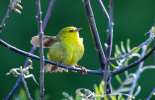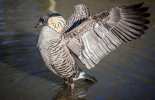03-12-2025
John C. Derrick
Hawaii Birds
Exploring Hawaii’s Unique Birdlife: Endemic Species Guide
This article may contain affiliate links. We earn a small commission at no extra cost to you. Mahalo!

Nene Hawaiian Goose
The Birds of Hawaii
Exploring the Diverse World of Hawaii Birds
Hawaii Birds occupy a unique niche in avian biodiversity. Situated thousands of miles from any major continental landmass, the Hawaiian archipelago evolved in near-total isolation for millions of years. This gave rise to a remarkable array of endemic bird species found nowhere else on Earth, showcasing evolution's creative power. These creatures are perfectly adapted to their island homes, including the incredible I'iwi or scarlet honeycreeper. Yet, this idyllic picture hides a harsh reality: Hawaii Birds also face an uncertain future, threatened by habitat loss, introduced predators, and climate change, turning the islands into a battleground for conservation.
Many come to admire Hawaii birds for their vibrant plumage and captivating songs, unaware of the ecological struggles they represent. These birds are more than just colorful flashes in a rainforest: They are living testaments to the delicate balance of island ecosystems. The birds stand as stark reminders of the urgent need to protect Earth's biodiversity.
Hawaii Nature Collection Merchandise
Our Hawai’i Nature Collection brings you closer to the stunning birds, fish, and other iconic symbols of the islands.
Explore our range of stickers, magnets, and pins—perfect for adding a touch of island life to your home, office, or personal style. Whether you’re a nature lover, a traveler, or simply enchanted by the beauty of Hawai’i, this collection offers something special for everyone.
Bring a piece of the islands home today!

Laysan albatross
Hawaii Birds: A Symphony of Evolution and Adaptation
Imagine an environment sculpted by volcanoes, where lush rainforests cloak mountainsides and sheer cliffs plunge into a sapphire sea. This is the stage on which Hawaii Birds evolved, diversifying to fill every conceivable niche, including the Black Noddy. Take, for example, the Mōlī (Laysan albatross), a magnificent seabird with the longest wingspan of any bird alive.
The Mōlī is capable of soaring effortlessly across vast stretches of ocean for years at a time. Then contrast it with the ‘Akiapōlāʻau, a Hawaiian honeycreeper equipped with a unique, curved beak. This beak is used to extract insects from tree bark like a miniature woodpecker. These are but two examples in a symphony of adaptations displayed by Hawaii Birds. It showcases nature's ability to equip its creations with the tools they need to thrive.
Avian Architects of Paradise
Before humans arrived, the Hawaiian islands were home to at least 113 endemic bird species. These birds weren’t just inhabitants; they were avian architects of this paradise, shaping its ecology in profound ways. The iconic ‘Ōhi‘a Lehua trees, with their fiery red blossoms, rely heavily on Hawaii Birds like the ʻIʻiwi, a honeycreeper adorned in scarlet feathers, for pollination.
As these birds flit from blossom to blossom, sipping nectar with their long, curved beaks, they transfer pollen, playing a critical role in the survival of this keystone species. Similarly, the bright red fruits of the native 'Ōhelo berry are a favorite food of the Nēnē, the state bird of Hawai'i. This handsome goose, once on the brink of extinction, relies on the ‘Ōhelo for sustenance.
These intertwined relationships highlight the intricate web of life that Hawaii Birds, including species like the Wandering Tattler and Common Waxbill, helped weave.
Endemic Birds Facing Extinction
While Hawaii Birds represent an evolutionary marvel, their story has taken a somber turn. Habitat destruction and degradation, spurred by human activities, dealt a severe blow to Hawaii Birds. Then came introduced species – rats, cats, mongooses – predators that these island birds had never encountered.
The birds had no natural defenses against the predators, which decimated populations, pushing many endemic species to the brink. As if this wasn't enough, avian diseases, such as avian malaria carried by introduced mosquitoes, further ravaged populations. Birds that had never developed resistance to these diseases succumbed rapidly. This deadly cocktail of threats has left a devastating mark.
Today, over 70 Hawaiian bird species are extinct, with many more teetering on the edge. This includes the critically endangered Kaua'i 'Ō'ō and the severely threatened Maui Parrotbill.

Conservation Efforts: A Beacon of Hope for Hawaii Birds
Faced with such stark realities, conservationists are engaged in a desperate race against time. There’s a fierce dedication to safeguarding surviving Hawaii Birds, exemplified by groups like the Maui Forest Bird Recovery Project. Their work focuses on creating safe havens within fenced reserves, protecting birds from predators. This gives them a fighting chance at survival.
Translocation, the careful movement of endangered birds to new habitats, offers a lifeline. Christa Seidl from the Maui Forest Bird Recovery Project underscores the critical importance of this approach, remarking, "We got mosquitoes to drop." These efforts are particularly crucial for species inhabiting elevation forests, where the impacts of climate change and invasive species are most pronounced.
This hope was echoed in a recent victory. A judge ruled in favor of mosquito control measures, a key strategy for battling avian malaria. This triumph arrived on the heels of a heartening discovery: a lone Kiwikiu, an endangered honeycreeper, resurfaced on Maui. This proves that these birds are tenacious fighters, clinging to existence against incredible odds. The reappearance of the Kiwikiu reminds us of the power of hope, even in the direst situations.
A Novel Approach to Mosquito Control: Fighting Fire with Fire
Conservation efforts for Hawaii Birds have embraced cutting-edge approaches, perhaps none more innovative than using a natural enemy to combat the invasive mosquitoes spreading avian malaria. The method, known as "incompatible insect technique," harnesses a naturally occurring bacteria called Wolbachia. Scientists release male mosquitoes infected with Wolbachia into the wild.
While these males can't transmit diseases, their mating with wild females results in infertile eggs. Over time, this controlled introduction is expected to reduce the mosquito population, providing relief for vulnerable bird populations. This method offers particular promise for protecting native forest birds in areas like the Big Island, where avian malaria has had a devastating impact.
Early results from pilot projects are encouraging, offering a potential lifeline to Hawaii's struggling avian populations. The "Birds, Not Mosquitoes" campaign exemplifies this new wave of conservation strategies. This approach acknowledges that saving Hawaii Birds requires a multifaceted approach – one that combats threats from various angles, not just addressing symptoms. Although these novel methods are in their early stages, their potential to change the trajectory of the crisis is palpable.
The Role of Community in Protecting Hawaii Birds
Protecting Hawaii Birds is not solely the responsibility of scientists and conservationists. Locals and visitors alike are embracing their roles as stewards. Organizations like Hawaii Audubon offer invaluable resources and programs that increase awareness.
They shed light on the fascinating world of these birds, such as the Java Sparrow and the Spotted Dove. They emphasize the importance of simple actions, like keeping cats indoors, planting native species that provide natural food sources, and advocating for responsible land management.
Hawaii Nature Collection Merchandise
Our Hawai’i Nature Collection brings you closer to the stunning birds, fish, and other iconic symbols of the islands.
Explore our range of stickers, magnets, and pins—perfect for adding a touch of island life to your home, office, or personal style. Whether you’re a nature lover, a traveler, or simply enchanted by the beauty of Hawai’i, this collection offers something special for everyone.
Bring a piece of the islands home today!

Apapane honeycreeper
Appreciating Hawaii Birds: More Than Meets the Eye
Witnessing the brilliant plumage of an ‘I‘iwi or hearing the melodious call of an ‘Apapane firsthand creates an unforgettable experience. Birdwatching becomes more than just a leisurely activity in Hawai'i: It becomes an intimate encounter with resilience and a stark reminder of the fragility of life. Several organizations, such as the Kolea Count and the Freeman Seabird Preserve encourage visitors to become citizen scientists.
These programs give people the opportunity to help by tracking bird sightings and documenting their behaviors, including those of the Red-footed Booby and the Short-eared Owl. This is particularly valuable for understanding the distribution and abundance of birds like the Common Myna and the House Finch, which are not native to Hawaii.
For audio enthusiasts and bird song enthusiasts, resources such as xeno-canto.org provide a rich library of recordings, offering a unique opportunity to listen to the sounds of the wild from the comfort of your home. You'll find contributions from skilled recordists like Patrick Blake and Dan Lane, capturing the essence of various bird calls. This includes those of endangered species such as the Akikiki. This makes appreciating Hawaii's avifauna accessible to people all over the world, bringing their music and their plight to life.
Conclusion
The story of Hawaii Birds is one of adaptation and fragility, a delicate balance between the triumphs of evolution and the ongoing threats to their survival. As ambassadors of the islands, these birds call upon us to recognize the preciousness of biodiversity and to act with urgency. By understanding the plights these birds face, appreciating their ecological significance, and actively participating in conservation, both locally and globally, there is a glimmer of hope. The hope is that the symphony of Hawaii Birds continues to grace these beautiful islands for generations to come.
Related Topics

Published by: John C. Derrick
Founder & certified Hawaii travel expert with 20+ years of experience in Hawaii tourism.
Hawaii Birds Photo Gallery












2025 Hawaii
Visitor Guides!
Visiting Hawaii soon?
View Yours Free
~ Detailed maps, insider tips, hotel recommendations, tour & activity suggestions, local dining, and more! ~
Affiliate Disclosure: We may earn commissions from some travel partners (like Amazon or Expedia) which helps us maintain this site. These links are at no extra cost to you and don't impact our honest & unbiased recommendations. Remove all the ads →



